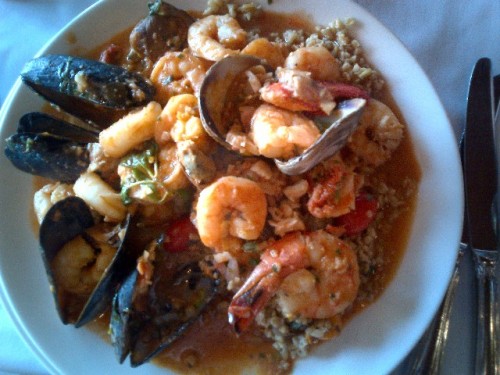More Than a Basic Wine Course
Wine Made Simple
By: Philip S. Kampe - Aug 10, 2014
The skill of tasting wine stems from practice. It is not a gift, but a facility we all have as our potential. It just takes a bit of practice and enjoyable patience to develop a palate for wine and its nuances.
Enthusiasm is the greatest tool to learning about wine. I remember when I set-up the cheese and gourmet food shop at a large ($60M a year) wine shop, that when the vendors left open bottles for management, after a presentation, I was the first to run to the tasting room and sample each and every wine. I couldn’t wait until the vendor left, so, I, could learn, on my own, about each wine, where it came from and what the grapes used were, what the aromas were and what I tasted on my palate.
You can do the same at the local complimentary, weekly, Saturday afternoon tastings at Nejaimes’s wines in both Lenox and Stockbridge and Spirited Wines in Lenox. Your local shop in West Stockbridge, Housatonic, Adams, North Adams or Williamstown may do the same.
The main reason for drinking anything, other than water, is for the sensations, aromas and flavors offered by the beverage. Beer, coffee, tea and fruit juice offer a door that opens the taste buds, but, wine is the entrance to the big door.
There are over 5,000 aroma compounds in wine and each wine contains a range in differing quantities. This fact makes wine the most diverse drink available in terms of aroma and flavor.
This makes wine tasting often mysterious to many. With a little practice the mystery will make sense and your appreciation for all wines will grow.
Not all wines will be remarkable. Some are made simply as a refreshing alcoholic drink or as an accompaniment to a meal. There is no need to over analyze these wines that are obvious food wines.
Wine transports us to another place or time. It is a window to the world.
When you pull the cork out of the bottle of wine the mystery begins. The aroma that is contained in both the cork and the bottle are clues to where the wine is from and what grapes were used to produce the wine.
Tasting a wine basically is finding the connection between the senses and the mind. It is partly a function of the eyes, nose and palate, demanding conclusions of your findings, through validation of the brain.
Sight and hearing are our most valued senses, followed by taste and smell.
When we pour a glass of wine, we immediately notice its color. Using your nose to better understand what you detect when you smell the wine will increase your sensitivity and develop the part of your brain that does most of the work, your memory.
Building the connection between the nose and the brain increases the enjoyment when tasting a glass of wine.
When we sniff a wine, a set of reactions takes place. As we breathe in, the aroma reaches the nasal cavity and then the olfactory receptor, which transmits information to the brain through millions of olfactory receptor cells. The information is eventually passed on to the brain where the information is assessed and then stored.
Individuals, obviously, differ in their ability to detect aromas.
Transferring the aromas to words usually involves the comparison of fruit, herbs, flowers, tobacco, candy, leather or whatever comparison one relates to.
In terms of true taste, the palate is quite simple in what it detects: saltiness, sweetness, sourness and bitterness.
Sweetness is the quickest to perceive because it is detected immediately with the tip of our tongue. Taste buds on the side of our mouth detect sourness. Bitterness and saltiness are rarely a consideration in wine.
Taste can be altered by a number of factors: Chilling a wine lessens the sweetness and raises the acidity, thus making a wine crisper and fresher. High sugar levels will lessen the sensation of acidity and vice versa. Generally speaking, alcohol levels above 14% increase the sense of sweetness in a wine and mask the aromas and flavors of the wine.
Saliva alters the composition of wine through dilution.
The ‘mouthfeel’ of wine, also referred to as texture and is important in understanding wine.. Tannins or astringency refer to the dry sensation some red wines give to the roof of the mouth and gums. The wine’s body composes all of the elements in the wine that aren’t water. Body consists of sugar, alcohol, glycerol, acidity, minerality and yes, aromatics.
It’s time for us to start a wine experiment.
Let’s try some wine together.
You will need a bottle of red or white, preferably both. A corkscrew and a tulip shaped wine glass that can swirl the wine.
It is best to taste wine in the morning, before lunch, when your taste buds are at their best. Sample the wine at home.
You will need a sheet of white paper or a white napkin or white cloth, to view the wine’s color. A few crackers are necessary to clean your palate.
The temperatures of the wines are important. Chill white wines generally to 54 degrees, roses to 57 degrees and reds to 64 degrees. Find a utensil to use as a spit bucket.
The tasting order of wines is very logical: White before rose, rose before red, dry before sweet and young before old.
Wine tasting encompasses more than just tasting in the mouth. The appearance and smell will give as much information as the palate.
Generosity is not a virtue in wine tasting. Pour a third or less of a glass at an angle. This will allow space for the swirling of wine (practice first with water). Pour your wine and evaluate the brightness and clarity of the wine. This is an indication of what to expect. Dull or hazy wines are questionable. The richness of the color will be determined by the grape variety and region.
To assess wines, let’s start with white wines. White wines will darken with age, just like the flesh of an apple. Red wines become paler as particles fall to form sediment. Red wines last longer because of the tannins.
The droplets of wine that fall down the inside of the glass after swirling are called legs. Legs are usually an indication of quality. Hold your glass by the stem and give it a generous swirl. Smell the wine. What do you think? If the wine smells strange in a bad way, it may have been oxidized by the air. The intensity of the smell can give many clues. Does the wine smell like a barnyard? Or dirty socks? Believe it or not, those are positive descriptors.
Each grape variety has a set of aromas. These aromas differ due to the winemaking process, soil and climate.
Now, it is time to taste the wine. Roll it around your mouth to coat your entire palate. Suck in a little air and keep your mouth open, doing so increases the wines exposure to air, which releases more flavor. Chew and roll the wine across your tongue, which releases even more flavor.
While you taste the wine on your palate, think about the structure of the wine first, then the flavors of the wine. . The structure is the taste and sensation detectable by the mouth. Consider sweetness and sourness. What is the feel in the mouth? Consider its body, astringency (tannins), temperature, balance and strength. What are the flavors that you taste on your palate?
Experiment at home and at the weekly complimentary wine tastings in the Berkshires. Pretty soon, you will be writing this column.
PhilipKampe@yahoo.com





